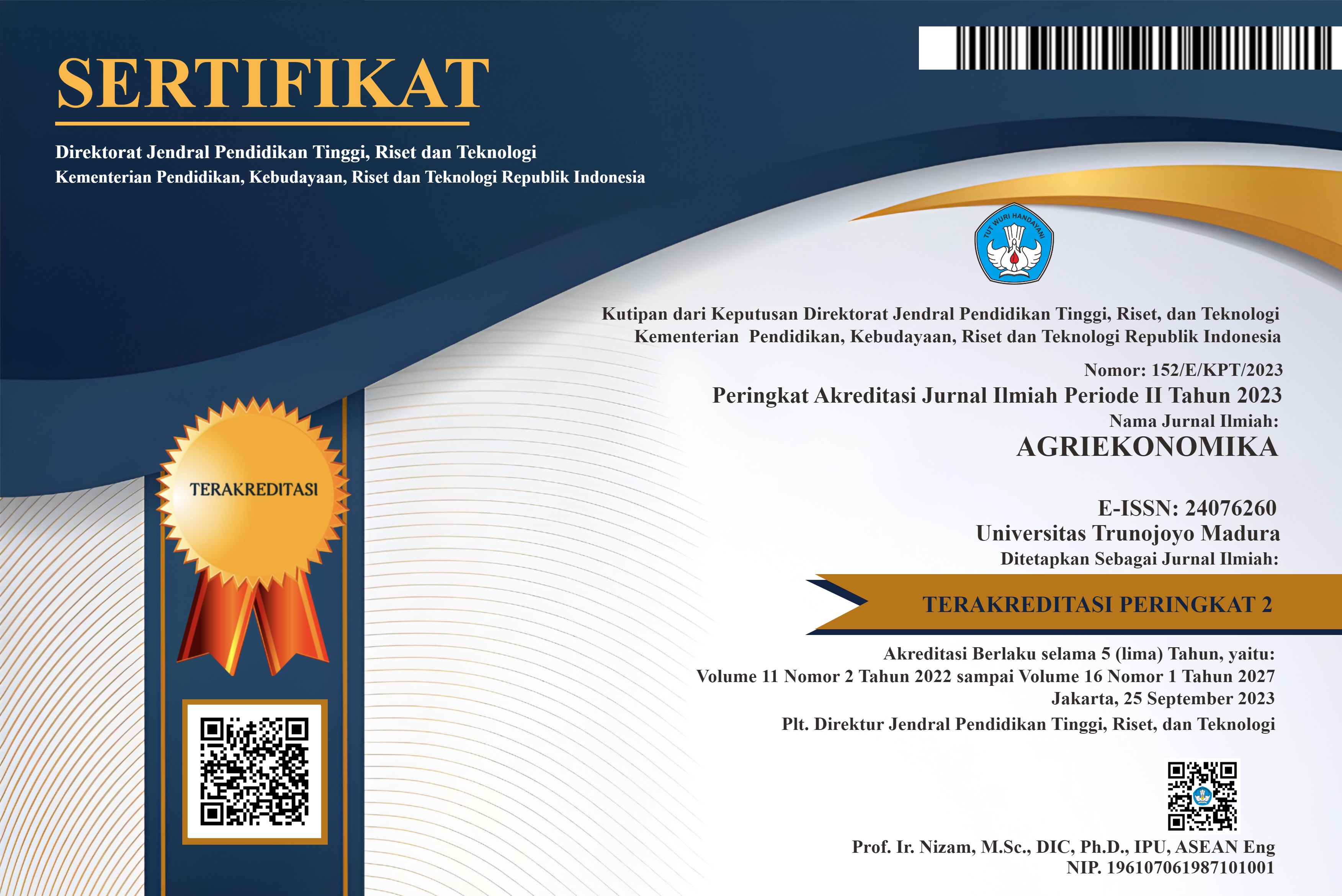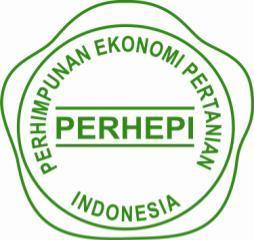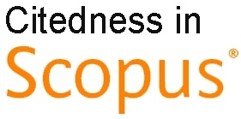Efficiency Comparison of the Cacao Intercropping Farming in Kolaka Regency
Abstract
The intercropping system is well-known for its extremely low risk of crop failure, its potential to overcome the risk of fluctuating product prices, and this system can save the production inputs. The study aims to compare the level of technical, allocative, and economic efficiency using the stochastic frontier production function model in the intercropping of cacao with annual crops with the pattern: cacao+coconut+patchouli; cacao+coconut+cashew; and cacao+coconut+banana. This research was conducted from March 2018 until April 2018 by determining the samples in the Kolaka Regency, which covered 17 sub-districts, taken from 3 sub-districts with purposive sampling. Each district was represented by 3 villages with purposive sampling. Each sub-district was represented by9 villages with total random samples of 270 respondents. The analysis used wasa technical, allocative, and economical efficiency analysis based on frontier analysis, with 270 respondents from 9 villages representing 3 sub-districts, using the random sampling method. The results discovered that the cacao intercropping farming system of cacao+coconut+patchouli had better technical, allocative, and economic efficiency values and was more feasible to cultivate compared to other patterns. The research results can be beneficial in developing cacao farmers’ performance relating to the annual intercropping crops. For academics, this research is expected to support the frontier production theory with the stochastic frontier efficiency model in cacao intercropping with annual crops.
Keywords
Full Text:
PDFReferences
Aigner, D., Lovell, C. A., Knox, L., & Peter, S. (1977). Formulation and Estimation of Stochastic Frontier Production Function Models. Journal of Econometrics, 6, 21-37.
Allen, L. H., T.R Sinclair, and E.R Lemon. (1976). Radiation and Microclimate Relationship in Multiple Cropping Systems. In M.Stelly. Madison,Wisconsin: American Inc. Wisconsin: 171.
Arsyad, M., Sabang, Y., Agus, N., Bulkis, S., & Kawamura, Y. (2020). Intercropping Farming System and Farmers Income. AGRIVITA. Journal of Agriculture Science, 42(2), 360-366.
Attipoe, S. G., Cao, J., Yaa, O. K., & Frank, O. S. (2020). The Determinants of Technical Efficiency of Cocoa Production in Ghana: An Analysis of the Role of Rural and Community Banks. Sustainable Production and Consumption, 23, 11-20. Doi: 10.1016/j.spc.2020.04.001
Besseah, F.A. & Kim, S. (2014). Technical Efficiency of Cocoa Farmers In Ghana. Journal of Rural Development 37(2), 159-182.
Budiman, K., Prihantini C.I, Hasbiadi, & Masitah. (2020). Financial Analysis of Annual Plant-Cocoa Intercropping Farming at Kolaka Regency. IOP Conference Series: Earth and Environmental Science, Volume 518, doi: 10.1088/1755-1315/518/1/012024
Cerda, R., Deheuvels, O., Calvache, D., Niehaus, L., Saenz, Y., Kent, J., Vilchez, A, V., Martinez, C., &Somarriba, E. (2014). Contribution Of Cocoa Agroforestry Systems To Family Income And Domestic Consumption: Looking Toward Intensification. AgroforestSyst, 88, 957-981. doi.org/10.1007/s10457-014-9691-8.
Effendi. (1976). Ilmu Usahatani. Bina Aksara. Jakarta.
Franzen, M., & Mulder, M. B. (2007) Ecological, Economic and Social Perspectives on Cocoa Production Worldwide. Biodivers Consev, 16, 3835-3849. doi.org/10.1007/s10531-007-9183-5.
Gebru, H. (2015). A Review on the Comparative Advantages of Intercropping to Mono-Cropping System. Journal of Biology, Agriculture and Healthcare, 5(9), 1-13.
Guay, M, M, O., Paquette, A., Dupras, J., & Rivest, D. (2018). The New Green Revolution: Sustainable Intensification of Agriculture by Intercropping. Science of the Total Environment, 615, 762-772. doi.org/101016/j.scitotenv.2017.10.024.
Haque, H. Z. (1984). Cropping System in Asia. On Farm Research and Management. IRRI, Los Banos.
Herliani, D, R., Sumarjono, D., & Setiawan, B, M. (2019). Analisis Pendapatan Usahatani Monokultur Kentang dan Tumpangsari Kentang-Carica Desa Sembungan Kecamatan Kejajar Kabupaten Wonosobo. SOCA: Jurnal Sosial Ekonomi Pertanian, 13(3), 291-303. doi.org/10.24843/SOCA.2019.v13.i03.p01.
Himmelstein, J., Ares, A., Gallagher, D., & Myers, J. (2017). A Meta-Analysis of Intercropping in Africa: Impacts on Crop Yield, Farmer Income, and Integrated Pest Management Effects. International Journal of Agriculture Sustainability, 15(1),1-10. doi.org/10.1080/14735903.2016.1242332.
Iqbal, N., Hussain, S., Ahmed, Z., Yang, F., Wang, X., Liu, W., Yong, T., Du, J., Shu, K., Yang, W., & Liu, J. (2019). Comparative Analysis of Maize-Soybean Strip Intercropping Systems: A Review. Plant Production Science, 22(1),131-142. doi.org./10.1080/1343943X.2018.1541137.
Kiwia, A., Kimani, D., Harawa, R., Jama, B., & Sileshi, G, W. (2019). Sustainable Intensification with Cereal-Legume Intercropping in Eastern and Southern Africa. Sustainability, 11, 2-18. doi.org/10.3390/su11102891.
Norman, N. J. T. (1979). Annual Cropping System in the Tropic. An introduction. Univ. Press. Florida Ginesville.
Soekartawi. (1990). Teori Ekonomi Produksi (Teori dan Aplikasi). Raja Grafindo. Persada. Jakarta.
Soekartawi. (2002). Teori Ekonomi Produksi dengan Pokok Bahasan Analisis Fungsi Cobb-Douglas, Cetakan ke 3. Rajawali Pers. Jakarta.
Tan, S., Heerink, N., Kuyvenhoven, A, & Qu F. (2010). Impact of Land Fragmentation on Rice Producers Technical Efficiency in South-East China. NJAS-Wageningen Journal of Life Sciences 57, 117-123. doi:10.1016/j.njas.2010.02.001.
Usman, R. (2004). Analisis Produktivitas Finansial dan Ekonomi Usahatani Kakao dalam Kawasan Hutan di Sulawesi tenggara. Perpustakaan. UGM. Yogjakarta.
Usman. R., & Abdi. (2010). Agroforestri, Solusi Sosial dan Ekonomi Pengelolaan Sumber Daya Hutan. Alfabetta. Bandung.
Wahyuni, A., Alamsyah, Z., & Damayanti, Y. (2018). Analisis Komparasi Pendapatan Usahatani Kelapa dalam Pola Monokultur dan Tumpang Sari di Kecamatan Mendahara Kabupaten Tanjung Jabung Timur. Jurnal Ilmiah Sosio-Ekonomika Bisnis, 21(1), 1-13. doi.org.10.22437/jiseb.v21i1.
Widodo, S. (1989). Production Efficiency Of Rice Farmers In Java Indonesia. Gadjah Mada University Press. Yogjakarta
Wijayanti, I., Jamhari, D. H. D., & Suryantini, A. (2020). Stochastic Frontier Analysis on Technic Effi-ciency of Strawberry Farming in Purbalingga Regency Indonesia. Jurnal Tekno Sains, 9(2), 91-180. doi.org/10.22146/teknosains.40944.
Yang, X., Sui, P., Shen, Y., Gerber, J, S., Wang, D., Wang, X., Dai, H., & Chen, Y. (2018). Sustainability Evaluation of the Maize-Soybean Intercropping System and Maize Monocropping System in the North China Plain Based in Field Experiments. Agronomy, 268, 1-15. doi.org/10.3390/agronomy8110268.
DOI: https://doi.org/10.21107/agriekonomika.v10i2.11090
Refbacks
- There are currently no refbacks.







